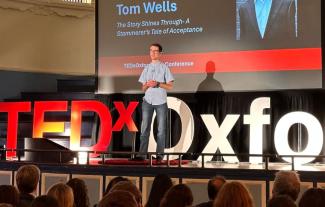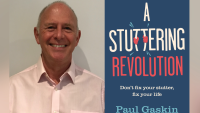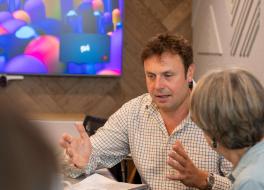My TEDx talk: Let's change the stammering framework

Tom Wells tells us about being chosen to present a TEDx talk and why he was keen for it to celebrate stammering. Read it and watch Tom's talk below.
You may have heard of TED, the well-renowned platform where professional speakers share and promote new technological and social changes that benefit global development.
It was a complete shock and honour to learn that I co-won the University of Oxford competition to present a TEDx talk (their events for local communities) around the theme 'We Are All Storytellers'.
As a passionate advocate of stammering, I chose to present a personal journey to celebrate my stammer as a distinctive part of my identity. It was a step away from the traditional divisions within our community to either 'fix' our condition, or to completely ignore our stammers and try and live and define our lives 'beyond it'. For me, this still restrains the condition within the negative stereotypes that STAMMA is trying to divert from.
I'm a slight anomaly in our community — I like public speaking more than talking to small groups.
I almost fell into this talk after meeting the TED committee president during the Oxford Freshers fair. He sent me an application form and, as I had recently seen a TEDx talk by Paul Gaskin called 'A Stuttering Revolution: Don't fix your stutter, fix your life', after reading his article on STAMMAs website, I believed I had strong opinions to share. His talk was great, but for me, it still operated within traditional frameworks; it was time to break free from those conventions and celebrate a stammer as a different form of verbal communication.
Article continues below...

Preparation & Presentation
I have to emphasise that I am only 20 at the time of writing. I had public speaking experience as a member of the Oxford Speakers Club and completed GCSE and A-level drama qualifications and extra-curricular events. But I had no experience on this scale.
It was a great help to read Carmine Gallo's book 'Talk Like TED: The 9 Public Speaking Secrets of the World's Top Minds'. From it, I learnt the importance of sharing an emotive connection with the audience. But as the book seems to be directed at 'fluent' speakers, it was great to come up with my own style.
Writing the speech was difficult. I had to think long and hard about how I wanted to communicate my ideas about a new framework, and learning the speech afterwards was complex (and I am grateful for the tips from peers and colleagues).
...it was time to break free from those conventions and celebrate a stammer as a different form of verbal communication.
You can watch my talk below. It was an amazing experience. I'm a slight anomaly in our community — I like public speaking more than talking to small groups. It almost felt like an out-of-body experience: I didn't have to worry about other people butting in, or feeling awkward, and I got to celebrate something that makes me unique. After the talk, and since then, I have received compliments from a variety of people who have used it to change their view of stammering.
All in all, I urge those who stammer, especially young people, to get involved and share your story! It doesn't have to be as public as a TED talk, but every story helps!
Read more Your Voice articles, including more from Tom.
Would you like to share your story, experiences, opinions, poems, art, music etc? See Submit Something For The Site or email editor@stamma.org to find out how.

































